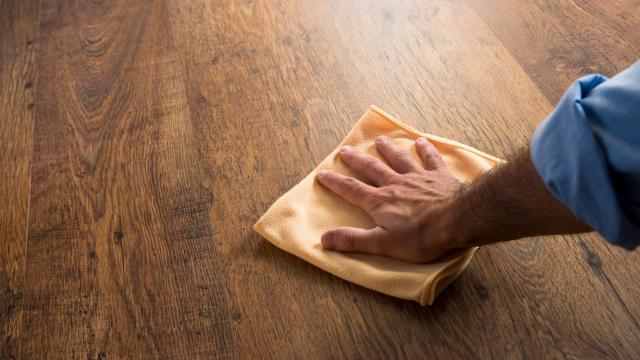Whether you installed it yourself, or inherited it from a previous owner (or it was there when you rented your home), real hardwood floors can change the feel of an entire space. Whether light- or dark-coloured, wide planks or parquet, hardwood floors are a sought-after feature in a home.
But actual hardwood floors (as opposed to laminate, vinyl, or tile flooring designed to look like wood) also take some work to maintain. Even though it can last for centuries, the condition will deteriorate over time without the proper care. Here’s what to know about cleaning your hardwood floor in a way that won’t damage it, courtesy of tips from the Hardwood Distributor’s Association (HDA).
Figure out the finish
If you already know what type of finish was used on your hardwood floor, then you can go ahead and skip this section. For everyone else, you’re going to want to figure that out. Here’s how the experts at the HDA suggest doing that:
To tell the difference in a pinch, just rub your finger across the floor. Be sure to do this on a clean floor. If no smudge appears, the floor is surface sealed. If you do create a smudge, the floor has been treated with a penetrating seal, oil finish, shellac, varnish or lacquer, and then waxed. Consider when your floors were installed as well. If you have a newer wood floor, it is likely surface sealed.
How to safely clean different types of hardwood floors
Regardless of the floor’s finish, the HDA recommends placing floor mats at all the exterior entrances to your home, both indoors and outdoors. Not only will that help prevent water damage when coming in from the rain or snow, but it’ll also help reduce the amount of dirt, grime, and grit getting into your home, and potentially harming the hardwood floor (having a sandpaper-like effect).
And as convenient as vacuums are, the HDA advises using a high-quality broom or microfiber cloth to clean hardwood floors on a daily basis. If you’re going to use a vacuum, make sure it’s one without a rotating beater bar (which can scratch the floor).
Sealed surfaces
If your hardwood floors were installed pretty recently, they likely have a sealed surface, also referred to as urethanes or polyurethanes, and have a protective coating that is durable and water-resistant.
The easiest way to find a safe cleaning product is to see what the flooring manufacturer recommends. If that’s not possible/available, the HDA says any generic hardwood floor cleaner will do — as long as they’re not wax- or petroleum-based.
Wax finishes
Only use cleaning products made specifically for wax finishes, and follow the directions carefully (including how long the product should stay on the floor). Then, after the floor is clean, apply a new coat of solvent-based wax, according to the HDA.
Acrylic impregnated finishes
These finishes create a very durable floor, when injected into the wood (hence the name). But they’re used primarily in high-traffic areas of commercial buildings, so they’re probably not in your home, the HDA explains.
In case they are (or you work somewhere that has them), you first have to figure out which finish was injected into the wood. For urethane-based finishes, follow the cleaning instructions for surface finished floors. For nonurethane-based finishes, use a spray and buff system, and products recommended by the manufacturer.

Leave a Reply
You must be logged in to post a comment.